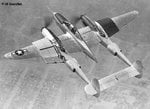evangilder
"Shooter"
There were not alot of TP-38s. At least that is what I have heard. Most pilots got the training that I mentioned from my conversation with Bob Grainger. That was training in the states, mind you. Before he got that "training", he had never flown a multi-engined aircraft!



